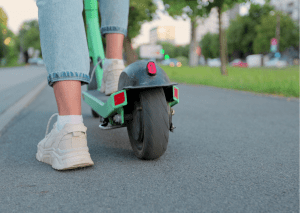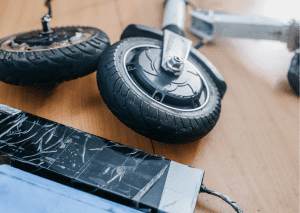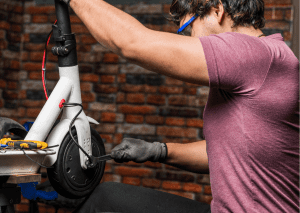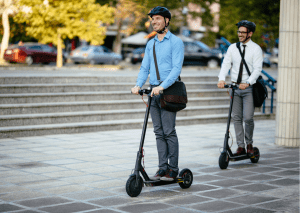Hey there scooter lovers! Are you feeling the frustrations that come with common scooter issues? Don’t worry, we’ve got you covered! In this article, we’ll explore the world of scooter troubleshooting, helping you to make sure your ride is both fun and safe.
We understand the feeling all too well, which is why we’re here to provide you with practical solutions. From understanding the common scooter issues to implementing proper scooter maintenance practices, we’ll be your guide every step of the way.
But more than just fixing problems, safety is our priority. We’ll be sharing essential safety tips that every scooter rider should know, so you can have an enjoyable and secure experience on the road.

We’re here to serve you, the electric scooter riders, by providing you with valuable information and practical solutions. We want to make sure you have the best scooter riding experience possible, so we’ve also included expert advice and resources to help you out. So, let’s dive in and make your scooter riding experience the best it can be!
Note: This content does not apply to gas-powered scooters.
A scooter is a vehicle with two or three wheels, a handlebar for steering, and an electric or petrol motor. Topics related to scooters include models, components, and types.
Common models include the Razor E100, Xiaomi M365, and Segway Ninebot ES2. Essential components include batteries, motors, and brakes. Types of scooters include kick scooters, electric scooters, and hoverboards.
As you troubleshoot your scooter, you’ll want to make sure to check these key elements and keep them well-maintained.
Key Takeaways
- Safety should be a top priority for riders, including wearing protective gear and following traffic rules and regulations.
- Regular maintenance practices, such as keeping electric scooters in working condition and checking components like the battery, charger, motor, brakes, tires, and handlebars, are essential for a smooth and safe ride.
- Seek expert advice and resources from platforms like FamilyHype, online forums, and communities to troubleshoot issues, find reliable repair services, and maintain performance and safety.
- Sharing feedback and experiences with the community is important for improving riding experiences and making informed decisions.
Scooter Troubleshooting Issues
Understanding common issues, including problems with the fuse or circuit breaker, is crucial for ensuring a fun and safe ride. When it comes to repair, knowing troubleshooting techniques can save you time and money. From flat tires to faulty brake levers, being able to diagnose and fix these problems will keep your scooter running smoothly. However, prevention is key.
In the next section, we will discuss proper maintenance practices to keep your scooter in top shape and avoid unnecessary repairs. This content is not for gas-powered scooters but focuses on electric models where issues such as battery life and fuse or circuit breaker, brake lever problems are more common.

The common issues associated with scooters are tire pressure, brake pads, brake levers, chain tension, and battery life. Through proper maintenance and troubleshooting techniques, you can ensure your model is safe and reliable.
By understanding the common issues associated with scooters, including how to troubleshoot a problematic fuse or circuit breaker, you can ensure a safe and reliable ride. Proper maintenance practices, such as checking tire pressure, brake pads, brake lever function, and chain tension annually, can prevent problems from arising and keep your model running smoothly. We hope this article has been helpful in understanding common issues and that it encourages you to practice safe and responsible riding.
Maintenance Practices
To ensure your model remains in top condition, it’s crucial to follow proper maintenance practices. By taking preventive measures such as regularly checking the tire pressure, inspecting the battery pack, oiling the chain, and cleaning the electric scooters, you can avoid common issues that can arise.
Additionally, learning troubleshooting techniques like identifying strange noises or vibrations, testing the circuit breaker, or checking the efficacy of the battery charger can help you address any problems before they become major. As we talk about proper maintenance practices of scooters, it’s important to note that this content doesn’t apply to gas-powered scooters.
It’s also important to mention the importance of regularly checking the brakes, checking for worn parts, and inspecting the battery life, battery pack, and the condition of the battery charger when it comes to proper maintenance.
Now that we’ve covered maintenance, let’s move on to safety tips for riders.
Troubleshooting Scooters Tips
When it comes to riding scooters, safety should always be the top priority. Wearing protective gear such as a helmet, knee pads, elbow pads, and other safety equipment is essential to ensure that riders are safe in case of any accidents. Also, taking care of the scooter’s electrical components and regularly inspecting the speed controller is vital for maintaining the safety and performance.
Additionally, all traffic rules and regulations should be followed to ensure a safe and smooth ride. To stay alert and aware of our surroundings, it’s important to be mindful of potential hazards on the road such as cars, cyclists, pedestrians, and other riders.

Maintenance also plays a crucial role in safety. Regularly checking the scooter’s electrical components, including the speed controller, can prevent malfunctions that could lead to accidents.
By following these safety tips, riders of electric scooters, kick scooters, and hoverboards can enjoy their ride while keeping themselves and others safe.
Wearing Protective Gear
Don’t forget to gear up with the right protective gear before hopping on your model for an exciting ride. A helmet is essential for protecting your head and is the most important piece of protective gear.
Knee pads and elbow pads are also important for providing extra cushioning from any falls. Wearing gloves is important to maintain a firm grip on the handlebars and protect your hands in case of a fall. Make sure to select the right helmet size to fit your head.
When it comes to scooters, safety is key. Following traffic rules and regulations is also an important factor to consider. Safety should always come first.
Following Traffic Rules And Regulations
Riding a scooter is a great way to travel, but it’s important to obey traffic rules and regulations to ensure a safe and secure journey. Just like any other vehicle on the road, you must follow traffic signals and signs to show respect for other drivers.
When driving a scooter, it’s important to practice defensive driving, which includes anticipating potential hazards and being prepared to react accordingly. By being mindful of our surroundings, we can stay safe on the road.
Additionally, this article focuses on scooters, so it’s important to remember the importance of being safe and respectful when riding one.
Being Aware Of Surroundings
It’s important to stay alert and mindful of your surroundings when using a scooter for a smooth and secure journey. This advice is especially crucial for electric scooters, as being aware of your environment can help you identify potential hazards and prevent accidents.
Keep an eye out for potholes, uneven surfaces, and other obstacles that could lead to damage or cause you to lose control of your scooter. By paying attention to these details, ensuring the power switch is functioning correctly, and being proactive about scooter maintenance, which includes regular check-ups of the battery charger port, you can ensure that your scooter remains in optimal condition.
We’ve gathered some expert advice and resources to help with troubleshooting your scooter, including common issues with the charger port and power switch.

In the world of transportation, the star of the show are the vehicles, and electric scooters are no exception. When it comes to electric scooters, some relevant factors include speed (maximum and current), power (battery and wattage), and weight (maximum and actual).
Electric scooters, like other vehicles, require regular maintenance to stay in working condition, so it’s important to stay aware of the macro co-occurring words such as brakes, tires, and handlebars, as well as micro co-occurring words such as air pressure, alignment, torque, charger port, and power switch.
Advice For Troubleshooting Scooters
Are you looking for some expert advice and resources to keep your non-gas-powered scooter, including its charger, running smoothly and enjoying a fun and safe ride?
Consulting online forums and communities dedicated to scooters can be a great source of troubleshooting techniques, including ensuring your charger works effectively.
Additionally, when it comes to reliable repair services, asking for recommendations from fellow scooter enthusiasts or checking online reviews can be beneficial. You can get advice about any aspect, from how to ensure your charger is in the correct “off” position when not in use, to more general maintenance tips.
If you need further guidance on how to maintain your scooter’s performance and safety, including the correct use of your scooter’s charger, don’t hesitate to reach out to experts in the field.
When it comes to the world of scooters, we’re here to provide you with the necessary information to make an informed decision. From understanding how your charger works to knowing when to turn the power to the “off” position, we’ve got you covered.
Conclusion
In conclusion, maintaining and troubleshooting your scooter, and ensuring all components are connected properly, including the electric scooter motors and wire connectors, is crucial for a safe and enjoyable riding experience. By understanding common scooter issues and following proper maintenance practices, you can prevent potential problems and extend the lifespan of your scooter.
Additionally, always prioritize safety by wearing protective gear and following traffic rules. Pay attention to all scooter components, from the electric motors to the wire connectors, to ensure they’re functioning as expected.
If you ever need expert advice or resources on how to keep these components connected or how to troubleshoot issues with your electric scooter motors or wire connectors.
Keep your scooter in top shape, ensure all components including the electric motors and wire connectors are in good condition, and have a blast riding it!
Frequently Asked Questions (FAQs):
What To Do If Your Scooter Doesn’t Start?
If your scooter doesn’t start, try checking the fuel level, battery charge, and whether the ignition key turns smoothly. If all these are in order, the problem could be in the starter system, electric motor, loose wires, or spark plug.
Why Is My Scooter Turning On But Not Moving?
If your scooter turns on but does not move, it could be due to a problem with the throttle, a drained battery, or an issue with the motor or wheels. It’s best to consult with a professional for a proper diagnosis as it could be about the brake lever switch.
Why Does My Scooter Keep Cutting Out?
If your scooter keeps cutting out, it could be due to a faulty battery or issues with the electrical wiring such as a short circuit of the motor. Overheating or a clogged carburetor (in a petrol scooter) could also cause this problem. Troubleshooting your electric scooter is not that easy so you need to check your user’s manual as well.
What Are The Common Problems With Electric Scooters?
Common problems in electric scooters or e-scooter can include battery drains, flat tires, faulty brakes, and issues with the throttle, key switch, or motor. Regular maintenance can help prevent most of these issues and the other components of the scooter such as the electric scooter’s fuse or circuit and brake cable.
How Do You Test A Scooter Battery?
To test a scooter battery, you will need a multimeter to perform a test power switch. Set the multimeter to DC voltage mode and connect the red and black probes to the positive and negative terminals of the battery, respectively. A reading of 12V or higher indicates a healthy battery. Charging the battery is important before doing the test. Make sure to check the battery the first and see if its fully charged before trying.
Why Is The Throttle Not Working On My Scooter?
If the throttle is not working on your scooter, it could be due to a damaged throttle cable or issues with the electronic controller or speed controller in electric scooters. You may need to replace the throttle or have it professionally repaired.
Why Is My Xiaomi Scooter Not Moving?
If your Xiaomi scooter is not moving, it could be due to a drained battery, motor issues, or a problem with the firmware. Try charging the scooter and restarting it to see if the issue resolves. It is important to check the battery percentage first or you can prepare for battery packs.
Why Is My Xiaomi Scooter Beeping And Not Working?
If your Xiaomi scooter is beeping and not working, the beep codes can help diagnose the problem. For example, a continuous beep might mean a communication error with the battery. Refer to the user manual or contact Xiaomi’s support for help. If things are not working properly, then you need to consult a professional.
How Do I Reset My Xiaomi Electric Scooter?
To reset a Xiaomi electric scooter, turn off the scooter, then hold down the power button for about 10 seconds until the scooter beeps and the lights flash. This should reset the scooter’s systems.
Where Is The Fuse On My Electric Scooter?
The location of the fuse on an electric scooter varies by model. Typically, it’s located inside the battery compartment or under the deck. Check your scooter’s manual to find the exact location.
DISCLAIMER (IMPORTANT): This information (including all text, images, audio, or other formats on FamilyHype.com) is not intended to be a substitute for informed professional advice, diagnosis, endorsement or treatment. You should not take any action or avoid taking action without consulting a qualified professional. Always seek the advice of your physician or other qualified health provider with any questions about medical conditions. Do not disregard professional medical advice or delay seeking advice or treatment because of something you have read here a FamilyHype.com.